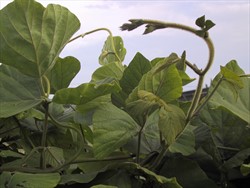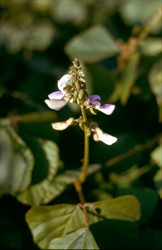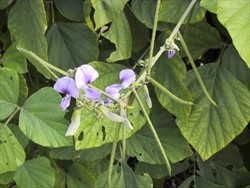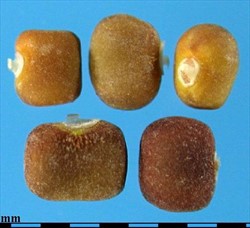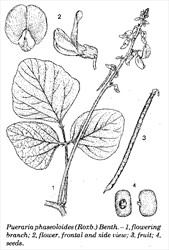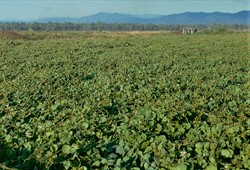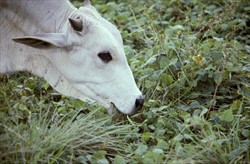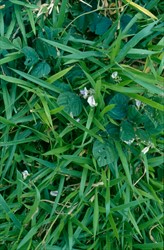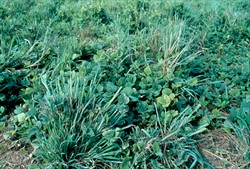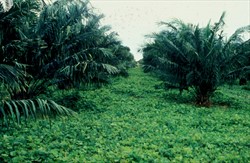Tropical Forages
Neustanthus phaseoloides (Roxb.) Benth.
Subordinate taxa:
Neustanthus phaseoloides (Roxb.) Benth. var. javanicus (Benth.) A.N. Egan & B. Pan
Neustanthus phaseoloides (Roxb.) Benth. var. phaseoloides
Neustanthus phaseoloides (Roxb.) Benth.: Pueraria phaseoloides (Roxb.) Benth.
var. javanicus: Basionym: Neustanthus javanicus Benth.; Pueraria javanica (Benth.) Benth.; Pueraria phaseoloides var. javanica (Benth.) Baker
var. phaseoloides: Basionym: Dolichos phaseoloides Roxb.; Pueraria phaseoloides var. phaseoloides (Roxb.) Benth.
Family: Fabaceae (alt. Leguminosae) subfamily: Faboideae tribe: Phaseoleae subtribe: Glycininae.
Vigorous, deep-rooted, perennial twining and climbing legume, slightly woody, hairy. Main stems are slender, 6 mm in diameter and up to 10 m in length, rooting at the nodes upon contact with moist soil. Secondary branches arise from the nodes to create a dense mass of vegetation 60‒75 cm deep if left ungrazed or uncut. Young shoots densely covered with brown hairs. Leaves large, trifoliolate, borne on petioles 5‒10 cm long covered with ascending hairs. Leaflets thin, ovate or rhombic, 2‒20 cm × 2‒15 cm, usually very shallowly lobed; lateral leaflets assymetrical, oblique 6‒7 cm long and wide. Flowers small, mauve to deep purple, borne in scattered pairs in axillary racemes about 15‒30 cm long on peduncles about 12.5 cm long. Pod straight, or slightly curved, linear, cylindrical, 4‒11 cm × 3‒5 mm, thinly covered with stiff adpressed hairs, turning black when ripe. Seeds 3 mm × 2 mm, oblong to squarish with rounded corners, brown to brownish black in colour. 10‒20 seeds/pod. 60,000‒90,000 seeds per kg.
var. javanica: leaflets mostly entire, rarely somewhat lobed; flowers 15‒23 mm long; bracts and calyx pubescent, lateral calyx lobes obtuse, lower calyx lobe acute; fruit 7‒11 cm × 4‒5 mm; the most common variety.
var. phaseoloides: leaflets entire, lobed or sinuate; flowers 7‒15 mm long; bracts and calyx short-pubescent, lateral calyx lobes acute, lower calyx lobe acuminate-lanceolate; fruit 5‒9 cm × 3-4 mm.
The Plant List also recognizes var. subspicata (Benth.) van der Maesen, which is described as follows:
var. subspicata (synonym: Pueraria subspicata (Benth.) Benth.): leaflets large, entire to deeply lobed; flowers 15‒23 mm long; bracts and calyx densely long-pubescent, lateral calyx lobes acute, lower calyx lobe lanceolate-subulate; fruit 7‒12.5 cm × 4‒5 mm. It occurs mainly in India, Bangladesh, Burma (Myanmar) and Thailand.
Asia: 三裂叶葛藤 san lie ye ye ge (Chinese); thotta-payar (Malayalam/Tamil, India); krandang, kacang ruji (Javanese), fuo banga (Ternate) (Indonesia); pièd, s'üak pièd (Laos); kacang hijau hutan, tampong urat (Malaysia); pe ying pin (Myanmar); ingkamasaso (Tagalog), bahay (Bikol), vaay (Ivatan) (Philippines); suak pied, thua-sianpa (Thailand); dâu ma, sắn dây dại, dâu dai, dâu rúng (Vietnam)
Caribbean: bwa mang (Lesser Antilles)
English: puero, tropical kudzu
Europe: kudzu tropical, puero (French); pueraria del tropico (Italian)
Latin America: cudzu tropical, puerária (Brazil); kudzú, kurzú, yerba kudzú, kudzú ordinario (Spanish)
Pacific: kūtū (Cook Islands); fa‘i sa‘a, kwalo sa‘a (Kwara‘ae, Solomon Is.)
Native:
Asia: Bangladesh, Bhutan, Brunei, Cambodia, China (Guangdong, Guangxi), Hong Kong, India, Indonesia, Laos, Malaysia, Myanmar, Nepal, Philippines, Sri Lanka, Taiwan, Thailand, Vietnam
Papuasia: Papua New Guinea, Solomon Islands
Naturalized:
Naturalized throughout the humid tropics.
Forage
Primarily used as a component of grazed and ungrazed cover crop mixtures, in particular in tree plantations such as those of rubber, oil palm and coconut in south-east Asia, Africa and tropical America, or as a component of grass-legume pastures in the humid tropics. Also used as hay, silage and cut-and-carry forage.
Environment
When used as cover crop and green manure, soil fertility is improved, and because of its growth habit and vigorous growth rate, it is a valuable pioneer species to control weeds and erosion, reducing the need for herbicide.
Other
Soil requirements
Wide adaptation to soil types, but not adapted to heavy clay soils. Commercial cultivar ('Common') well-adapted to well-drained, acid soils (pH 3.5‒5.5) with high Al saturation, but requires medium to high soil fertility. Grows best within a pH range of 4.0‒6.5 and requires P, S and Mg. Does not tolerate salinity.
Moisture
Prefers annual rainfall regimes of >1,500 mm, but will grow in the sub-humid tropics in 1,000‒1,500 mm/year rainfall environments. Reported to be tolerant of temporary waterlogging and short periods of flooding. Poor drought tolerance. Puero will survive a dry season of 4‒5 months, but will experience appreciable leaf loss.
Temperature
Optimum temperature 32/24 °C (day/night), minimum temperature 12.5 °C. Grows up to 1,600 m asl in the tropics. Good yields obtained at 1,500 m asl in the Colombian Andes. Poor frost tolerance.
Light
Moderately shade tolerant and therefore used as a cover crop in young stands of tree plantations and in mature coconut plantations.
Reproductive development
In the Brazilian savannas, at latitude 16º S, puero did not flower in the establishment year. In subsequent years, flowering took place from April to May. Time from first flowering to seed harvest was constant between years at ~75 days. Observations suggest a weak short-day photoperiodic response reduced by high moisture availability.
Defoliation
Persists under moderate grazing pressure with continuous and rotational grazing on well-drained soils as it has relatively low palatability during the growing season and a stoloniferous growth habit. Recovers well after lenient grazing, but can be sensitive to heavy grazing, particularly on poorly drained soils.
Fire
Little tolerance of fire.
Guidelines for establishment and management of sown forages.
Establishment
Seed must be mechanically, chemically or hot water scarified to break the hard seed coat for optimum germination. Cover crops are seeded at a rate of 4 kg/ha, at a depth of 1‒2 cm into a well-prepared seedbed. In pasture mixtures, seeding rates of 0.5‒1.0 kg/ha are commonly used. Early growth (first 6 months) is slow compared with Calopogonium mucunoides, but subsequent growth is generally excellent. Can also be established using stolons. Promiscuous, but benefits from inoculation with Bradyrhizobium strains CIAT 2434, CIAT 3850 or CIAT 3918.
Fertilizer
Requires P at establishment. Subsequent fertilizer dressings for maintenance should be applied at 50% of the establishment rate. As a green manure crop, the legume decomposes rapidly providing 50‒100 kg N/ha/year. Will respond to micronutrient application in some cases.
Compatibility (with other species)
Generally more compatible with erect species. However, under moderate grazing pressure on well-drained soils in high rainfall environments, persistent associations have been formed with stoloniferous grasses, e.g. Urochloa mutica in Vanuatu and U. brizantha in Brazil.
Companion species
Grasses: Andropogon gayanus, Melinis minutiflora, Megathrysus maximus and Cenchrus purpureus. The commercial cultivar has associated well with Urochloa decumbens cv. Basilisk in the Colombian Llanos.
Legumes: For cover crop in Southeast Asian tree plantations (rubber, oilpalm), N. phaseoloides is often sown in a mixture with Calopogonium mucunoides, C. caeruleum, Centrosema molle and Grona heterocarpa subsp. ovalifolia, as a strategy to combine different growth rates with different levels of shade tolerance.
Pests and diseases
None of significance. However, leaf spot (Pseudocercospora puerariae) is common throughout tropical America, causing defoliation under humid conditions. Anthracnose (Colletotrichum gloeosporioides) has been reported in Brazil, Colombia, Ecuador, Peru, Venezuela and some Caribbean islands. Under prolonged humid conditions, the plant can be defoliated by foliar blight (Rhizoctonia solani), but recovers with dry weather.
Ability to spread
Rapid once the legume has established; spreads by stolons and seed.
Weed potential
Has considerable weed potential in humid tropical environments where it can be an aggressive climbing/smothering plant.
Nutritive value
The legume has high levels of protein (CP 12‒24%) and minerals, particularly Ca, and has high digestibility (IVDMD 60‒70%). In Nigeria, 6-month regrowth had in-sacco DMD of 52%, CP 14%, P 0.29% and Ca 0.80%, the indicators of nutritive quality declining slightly in the dry season. In Villavicencio, Colombia, chemical characteristics of 6-week-old herbage regrowth were IVDMD 50%, CP 22.6%, P 0.30% and Ca 0.65% in the wet season, compared with 55.5, 19.8, 0.23 and 0.52%, respectively, in the dry season.
Palatability/acceptability
Requires a period of adaptation by cattle. Commonly of only low to moderate palatability to grazing cattle in the wet season but of higher palatability in the dry season.
Toxicity
None reported.
Feedipedia links
Dry matter
Annual DM yields of pure stands are high for a twining legume, ranging from 5 to 10 t/ha, with highest yields occurring in tropical environments with very short, or no dry season. Production in the dry season is low, due to leaf fall, but rapid regrowth occurs with the first rains. In south-west Nigeria, unfertilised mixtures of with Megathrysus maximus or Cenchrus purpureus produced 13.6 t DM/ha/year and transferred approximately 40 kg N/ha to the grasses. In a 4-year field trial at Porto Velho, Rondônia, Brazil on a dark-red podsolic soil, a pasture mixture of Urochloa brizantha and produced an average annual yield of 35.3 t DM/ha, compared with 32.0 t/ha for fixed 194 kg N/ha/year and transferred 75 kg N/ha to the grass. N fixed and transferred was significantly higher than for other common twining and herbaceous legumes.
Animal production
In the Colombian savannas, associations with Urochloa decumbens grazed at 2 head/ha produced cattle LWGs of 160 kg/head/year, compared with 120 kg/head/year from grass alone. Daily animal gains ranged from 400 to 700 g/head. In humid tropical Vanuatu (south-western Pacific), the addition of to a para grass ( Urochloa mutica) pasture improved production by 22%, increasing annual LWGs from 511 to 621 kg/ha, and individual steer LWGs from 550 to 650 g/head/day over a 3-year experimental period.
2n = 22, self-fertile. There are no breeding programs to improve . Two varieties are recognized by GRIN, var. phaseoloides, which has acute calyx lobes, and var. javanica, which has short, blunt calyx lobes and is a comparatively more robust plant. TPL recognizes a third variety, var. subspicata.
There are difficulties with seed production at some locations. Accordingly, seed yields are variable. In the Cauca Valley, Colombia, at latitude 3° N, pure seed yields were 38‒70 kg/ha. In the Brazilian savannas (16° S), hand-harvested pure seed yields were also moderate at 110‒136 kg/ha. At other locations, on fertile soils with a high organic matter content, pure seed yields have been 400‒500 kg/ha. Plants require support, e.g. trellises, for high seed production and ease of hand-harvesting.
The legume pod borer Maruca testulalis, the pea blue butterfly Lampides boeticus and Heliothis/Helicoverpa spp. attacked developing seed pods in northern Australia. Repeated applications of methomyl at 0.45 kg a.i./ha were required to achieve control.
Tolerant of post-emergent applications of 2,4-D (0.08‒0.48% solutions) and pre-emergent applications of alachlor (4.0 kg/ha) and haloxyfop, ametryne, linuron and 2,2-DPA. Susceptible to post-emergent applications of 2,4-DB and pre-emergent applications of pendimethalin.
- Tolerance of soil acidity.
- High nutritive value.
- Shade tolerance makes it suitable for plantation agriculture.
- Persistent (for a twining legume) due to only moderate palatability.
- Moderate palatability.
- Requires medium to high fertility soils.
- Slow to establish.
- Lack of drought tolerance.
- Variable seed yields.
- High weed potential in the humid tropics.
Costa, N.L. (1993) Agronomic evaluation of Brachiaria brizantha cv. Marandu in mixtures with forage legumes in Rondônia. Lavoura Arrozeira 46:10–12.
Halim, R.A. (1992) Pueraria phaseoloides (Roxb.) Benth. In: Mannetje, L.’t and Jones, R.M. (eds) Plant Resources of South-East Asia No. 4. Forages. Pudoc Scientific Publishers, Wageningen, the Netherlands. p. 192–194. edepot.wur.nl/327785
Maesen, L.J.G. van der (1985) Revision of the genus Pueraria DC. with some notes on Teyleria Backer (Leguminosae). Agricultural University Wageningen Papers 85–1. Wageningen Agricultural University, the Netherlands. edepot.wur.nl/165042
Muhr, L., Tarawali, S.A., Peters, M. and Schultze-Kraft, R. (1999) Forage legumes for improved fallows in agropastoral systems of subhumid West Africa: I. Establishment, herbage yield and nutritive value of legumes as dry season forage. Tropical Grasslands 33:222–233. bit.ly/2WDa6vP
Mullen, B.F. and Macfarlane, D.C. (1998) The effect of band-seeding legumes into para grass (Brachiaria mutica) on pasture production, sustainability and animal productivity in Vanuatu. Tropical Grasslands 32:34–40. bit.ly/3bE8dTL
Tian, G., Hauser, S., Koutika, L.S., Ishida, F. and Chianu, J.N. (2001) Pueraria cover crop fallow systems: benefits and applicability. In: Tian, G., Ishida, F., Keatinge, D., Carsky, R. and Wendt, J. (eds) Sustaining soil fertility in West Africa. SSSA Special Publication 58. SSSA, ASA, Madison, WI, USA. p. 137–155. doi.org/10.2136/sssaspecpub58.ch7
'Jarocha' Released Mexico (1989). 'Jarocha' is the common commercial cultivar (e.g. CIAT 9900). Widely available in other tropical American countries.
'IAC' Released in Brazil at an unknown date. Likely to be the same as 'Jarocha'.
'Common' Available and widespread throughout Southeast Asia. Does not appear to have been formally released there and this ecotype is possibly the same as both 'Jarocha' and 'IAC'.
'Reyan No. 17' (CPI 32118) Released by CATAS (Chinese Academy of Tropical Agricultural Sciences) for Hainan and Yunnan, China (2006) for use in tree plantations. Reported to be adapted to shade, poor soils, drought and waterlogging.
CIAT 18031: performed well in agronomic trials in Venezuela.
CIAT 7182, CIAT 8042, CIAT 17323, CIAT 19402, CIAT 19553, CIAT 20606 and CIAT 22288: demonstrated best drought tolerance in a 25-accession core collection of N. phaseoloides evaluated at Villavicencio, Meta department, Colombia.


